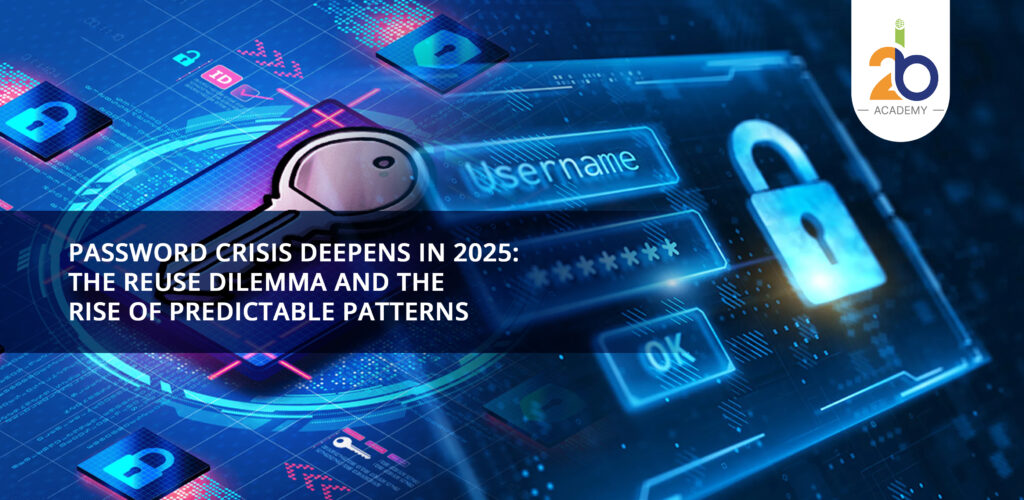
Table of Contents:
- Introduction: The Password Crisis in 2025
- The Reuse Epidemic: Why Weak Passwords Persist
- Analyzing the 2025 Password Trends
- Popular Yet Predictable: The Anatomy of a Weak Password
- The Credential-Stuffing Goldmine: Reused Passwords as a Hacker’s Dream
- Impact on Organizations: How Reused Passwords Facilitate Cyberattacks
- Building a Stronger Defense: Best Practices for Password Hygiene
- Conclusion: The Path Forward for Secure Authentication
- About 2B Academy: Empowering Future Cybersecurity Leaders
The Password Crisis in 2025
It’s 2025, and despite relentless warnings from cybersecurity experts, the password crisis is only deepening. A recent study has revealed that a staggering 94% of passwords in circulation are reused or duplicated, putting millions of users at heightened risk of cyberattacks. From lazy keyboard patterns like “123456” to profane or offensive words, the sheer predictability of these passwords is alarming. But what is driving this persistent trend of weak, reused passwords despite the mounting risks?
The Reuse Epidemic: Why Weak Passwords Persist
For years, the digital landscape has been plagued by recycled passwords that are easy to guess and vulnerable to brute-force attacks. Despite the rise of advanced authentication methods, many users continue to default to predictable patterns that attackers can easily exploit. The data from 2024-2025 shows that only 6% of passwords are unique, leaving the remaining 94% as low-hanging fruit for cybercriminals.
The root of the problem lies in user behavior. Convenience often trumps security, leading people to choose short, memorable, and easily guessed words. As a result, familiar names, keyboard patterns, and common phrases dominate the list of exposed credentials.
Analyzing the 2025 Password Trends
The Cybernews research team analyzed over 19 billion newly exposed passwords from 2024-2025, uncovering a worrying trend:
- Short Lengths and Simple Patterns: Nearly half of all passwords consist of 8-10 characters, with “123456” being the most common.
- Lowercase Dominance: More than a quarter of the passwords consist solely of lowercase letters and digits, making them highly susceptible to brute-force attacks.
- Names and Positive Words: From “Ana” and “Mario” to “love” and “sun,” users often draw from familiar names and uplifting concepts, mistakenly believing that these choices will remain unpredictable.
These patterns reveal a broader issue – users cling to familiarity, creating a dangerous loop of easily compromised passwords.
Popular Yet Predictable: The Anatomy of a Weak Password
A deep dive into the dataset revealed that simple, default passwords like “admin,” “password,” and “123456” remain as popular as ever. Despite being called out for years, these easy-to-guess credentials still account for millions of exposed passwords.
Even worse, many users still rely on pop culture references and positive associations. Words like “Batman,” “Thor,” and “Joker” are prevalent, with each appearing millions of times in leaked datasets. While these passwords may feel unique to the user, their ubiquity makes them prime targets for attackers.
The Credential-Stuffing Goldmine: Reused Passwords as a Hacker’s Dream
Credential-stuffing attacks – in which hackers use automated tools to test stolen passwords across multiple platforms – are becoming increasingly lucrative. The 2025 dataset highlights a significant rise in reused passwords, making credential stuffing easier than ever.
Attackers can now tap into databases loaded with billions of exposed credentials, exploiting common passwords and patterns to gain unauthorized access. For organizations, this means that a single breach can quickly escalate into a multi-platform compromise, with hackers using the same passwords to infiltrate multiple accounts.
Impact on Organizations: How Reused Passwords Facilitate Cyberattacks
The consequences of reused passwords extend beyond individual users, posing a severe risk to organizations. A single compromised password can provide attackers with a gateway to sensitive data, allowing them to escalate privileges, deploy ransomware, or exfiltrate confidential information.
Moreover, the rise in credential-stuffing attacks means that even seemingly minor breaches can have catastrophic consequences. Once attackers gain access to one account, they can use the same password to target other platforms, amplifying the impact of the breach.
Building a Stronger Defense: Best Practices for Password Hygiene
To mitigate the risks associated with reused and predictable passwords, users and organizations must adopt stronger security practices:
- Use Unique, Complex Passwords: Each password should be at least 12 characters long, incorporating uppercase and lowercase letters, numbers, and special characters.
- Implement Multi-Factor Authentication (MFA): Even if passwords are compromised, MFA adds an extra layer of protection, preventing unauthorized access.
- Leverage Password Managers: These tools can generate and store unique passwords, reducing the temptation to reuse the same credentials.
- Regularly Update Passwords: Periodic password resets can limit the effectiveness of stolen credentials.
- Monitor for Leaks: Organizations should deploy tools to detect leaked credentials and alert users to potential compromises.
The Path Forward for Secure Authentication
The 2025 password crisis underscores a troubling reality – despite years of awareness campaigns, password reuse remains rampant. With billions of exposed credentials flooding the dark web, the risks associated with weak passwords have never been higher.
Organizations must act swiftly, implementing stronger password policies, adopting MFA, and educating users about the dangers of predictable patterns. Meanwhile, individuals must rethink their approach to password creation, embracing longer, more complex combinations that defy common patterns.
About 2B Academy: Empowering Future Cybersecurity Leaders
At 2B Academy, we’re committed to preparing the next generation of cybersecurity professionals to tackle the challenges of tomorrow. From advanced password security strategies to cutting-edge data protection techniques, our courses equip students with the skills and knowledge they need to stay ahead of emerging threats.
Join us as we explore the evolving landscape of digital security and learn how to safeguard sensitive information in a world of ever-growing cyber risks.
Stay informed. Stay prepared. Explore our offerings at 2B Academy and be the first line of defense against cyber threats.